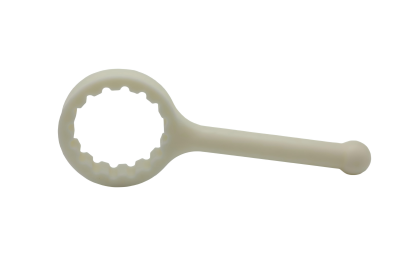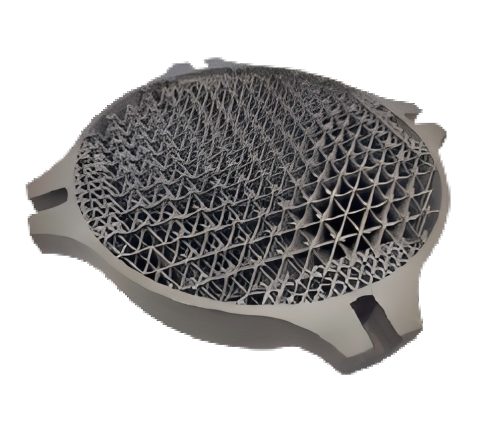Compare 3D Printing Materials
Explore and compare 3D printing materials to find the best fit for your project. From durable plastics to flexible resins, our guide highlights key properties like strength, flexibility, and surface finish, helping you choose the right material for prototyping, production, or custom parts.
PC-Like Translucent
Process: SLA
Transparency, Stiffness
PC-like translucent material combines excellent translucency with high stiffness, making it an ideal choice for precision components. Through customized post-processing, functional light-transmitting effects can be achieved, delivering both aesthetic appeal and performance. With high tensile strength and modulus, this material is especially suited for creating functional prototypes that emulate injection-molded polycarbonate, meeting the dual demands of mechanical performance and visual quality for engineering prototypes and small-batch production.
PC-Like Advanced Temp
Process: SLA
Temperature Resistance, Strength, Stiffness
PC-Like Advanced High Temp is a high-temperature reinforced material with properties similar to polycarbonate, specifically designed for functional parts that require a combination of high strength, stiffness, and heat resistance. Post-curing can further increase the heat deflection temperature of the parts, enhancing their stability and reliability in high-temperature environments. It should be noted that post-curing may reduce some aspects of durability, so a balance between strength and toughness should be considered during design.
Ceramic-Like
Process: SLA
Heat Resistance, Strength, Stiffness
The high-temperature reinforced ceramic white combines exceptional heat resistance with outstanding strength and stiffness, making it an ideal choice for functional parts and high-performance prototypes. Post-curing further enhances its mechanical properties and thermal stability, providing reliable performance for complex geometries. Whether for aerospace, precision molds, electronic insulators, or laboratory equipment, this ceramic material meets the highest standards under demanding conditions, delivering solid support for innovative designs and high-performance manufacturing.
Inconel 718
Process: SLM
Fatigue Resistant, Temperature Resistance, Corrosion Resistance, Strength
Inconel 718 is known for its outstanding high-temperature strength, creep resistance, and corrosion resistance. The material can withstand operating temperatures above 700°C while maintaining excellent fatigue and fracture resistance. Through additive manufacturing, GH4169 can produce parts with complex geometries and is widely used in aerospace engines, gas turbines, high-temperature molds, and high-performance industrial components.
Disadvantages: High cost; complex heat treatment process; thin-walled structures require careful design; default surface roughness Ra10–12.Stainless Steel 17-4PH
Process: SLM
Corrosion Resistance, HighStrength, Wear Resistant
17-4 PH stainless steel is a precipitation-hardening stainless steel known for its excellent hardness and corrosion resistance. Through vacuum solution heat treatment and H900 aging treatment, printed parts can achieve high strength, high hardness, and good wear resistance. 17-4 PH stainless steel is suitable for manufacturing industrial components that require high strength, corrosion resistance, and complex structures, such as aerospace parts, molds, and high-load machinery.
Disadvantages: Low elongation (≤16% after heat treatment); weak magnetism after heat treatment.Titanium
Process: SLM
Temperature Resistance, Corrosion Resistance, Strength, Lightweight
3D printed titanium alloys, represented by Ti6Al4V, feature extremely high specific strength and excellent corrosion resistance, while being lightweight and tough. They enable the creation of complex geometries and topology-optimized designs through additive manufacturing, and are widely used in aerospace, medical implants, automotive, and high-performance sports equipment. Titanium alloys also offer good high-temperature performance and biocompatibility, making them an ideal choice for manufacturing high-performance, lightweight components.
Disadvantages: Poor heat resistance (maximum 120°C); surface roughness around Ra10, with slight pits and visible layer texture.Aluminum
Process: SLM
HighStrength, CorrosionResistant, Lightweight
3D printed aluminum alloys, represented by AlSi10Mg and other aluminum-silicon-magnesium alloys, combine lightweight characteristics with excellent mechanical properties. They offer an outstanding strength-to-weight ratio, good corrosion resistance, and thermal conductivity, and demonstrate excellent fatigue and fracture resistance after heat treatment. The material is easy to form, weld, and machine, making it ideal for aerospace, automotive, and tooling applications where lightweight design and structural complexity are critical. Finished parts are typically shot-peened for surface treatment. If you require any other post-processing, please inform our customer service clearly.
Disadvantages: Poor heat resistance (maximum 120°C); surface roughness around Ra10, with slight pits and visible layer texture.








